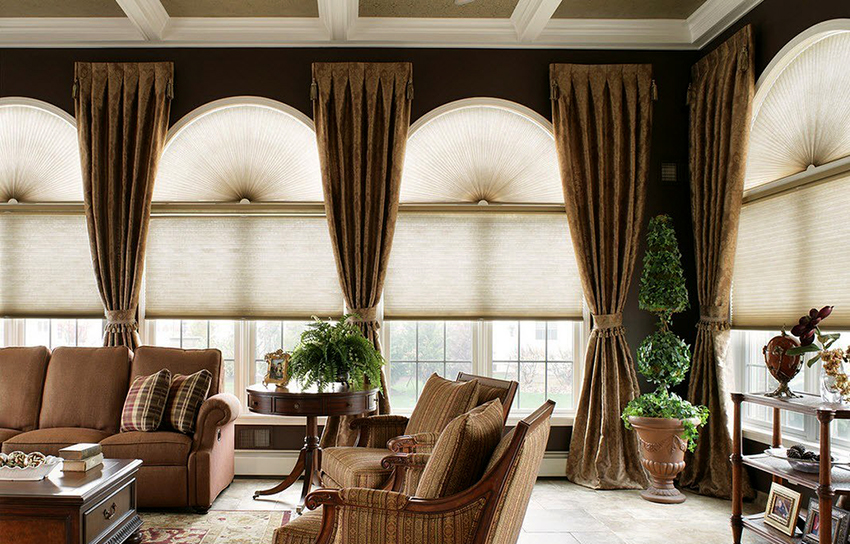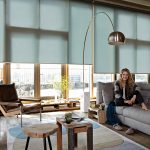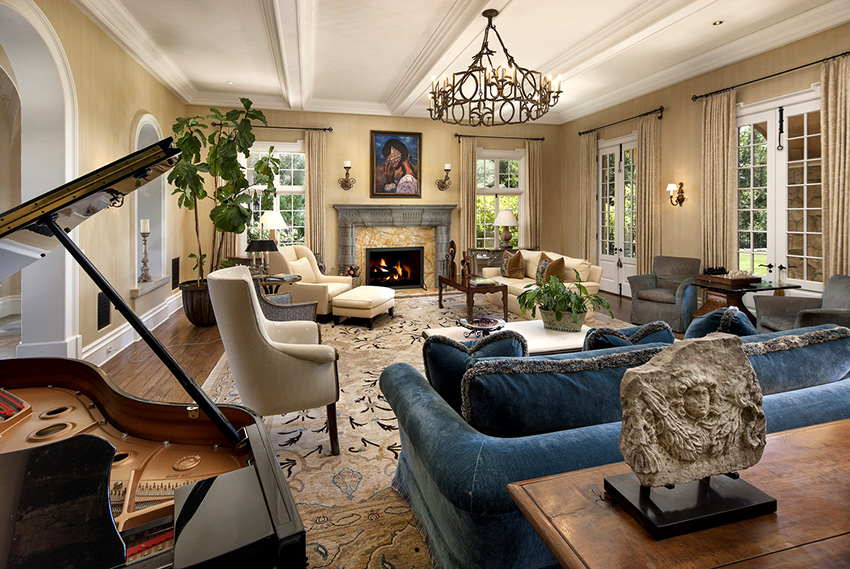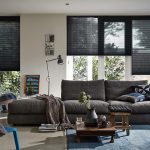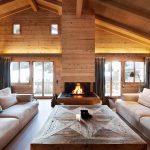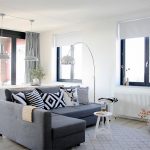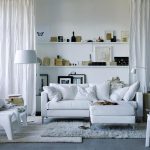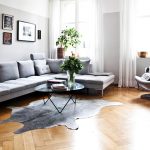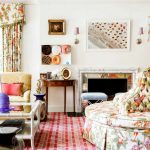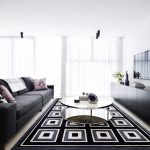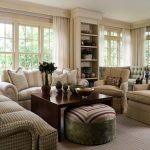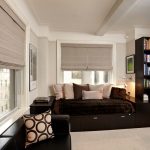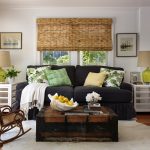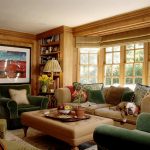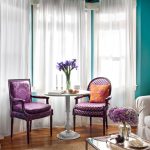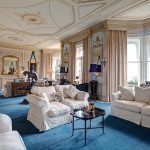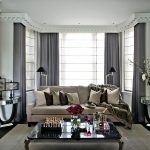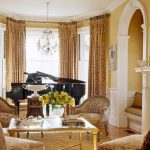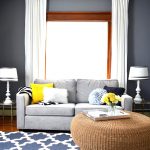Why is it difficult to stay in a room without windows for a long time? Even in the best lighting conditions, you experience discomfort. A window is a connection with the outside world, even if it is closed and shaded. Its appearance should evoke positive emotions. Therefore, the window must be properly decorated. Especially in a living room, especially in a hall. Designers offer curtains for the hall: photos of interesting interior design options are posted in this article.

Beautiful and well-chosen curtains able to transform the living room as much as possible
Content [Hide]
- 1 Are curtains really needed in a modern room?
- 2 Classics in the interior: photo of the design of curtains for the hall
- 3 Decorating curtains for the hall with lambrequins on a rigid base
- 4 Features of the selection of curtains for a hall with two windows or more
- 5 Options for curtains in the hall for decorating a window block
- 6 Hall curtains: Scandinavian design solutions
- 7 Functional and decorative: tulle and curtains in the hall
- 8 Roman blinds in the hall: photos of natural and synthetic fabrics in the interior
- 9 Designer tips: photo of curtains for the hall with bay windows
- 10 Modern types of cornices used for hall curtains
- 11 How to sew beautiful curtains for the hall with your own hands
Are curtains really needed in a modern room?
If you ask this question to the average residents of residential areas, most of them will confidently answer in the affirmative. However, there are many who will think or even nod negatively, explaining this answer by the fact that these are additional dust collectors, etc. There is no reason to assert that their presence is necessary. However, it is framed window becomes part of the interior, otherwise it will only be a source of light and fresh air.
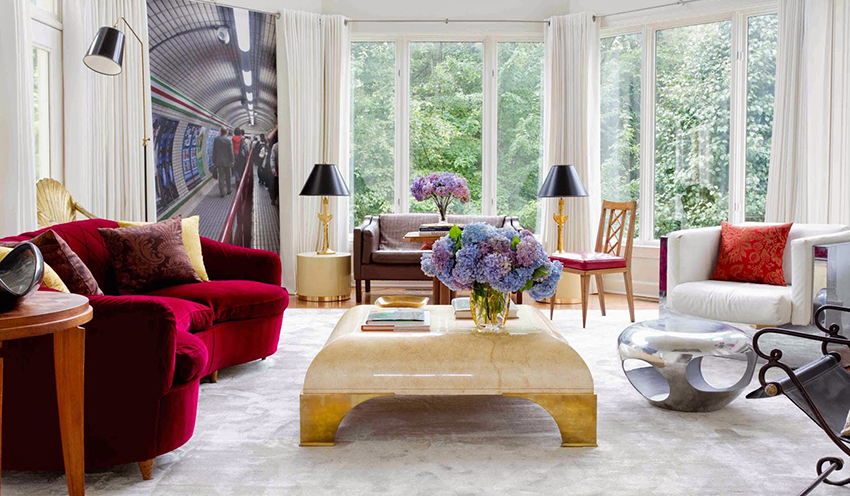
Many designers believe curtains an integral part of the interior of the hall
If you do not rely on opinions, but look at the work of professional designers, the conclusion will be more obvious. Studying a selection of photos of rooms decorated in the loft style (the least romantic), the curtains may not immediately be noticed - they are so harmonious to the setting. And with the halls made in the style of hi-tech or minimalism, the situation is repeated. This is an additional confirmation that photos are better than verbal descriptions can tell you how to choose curtains for the hall.
Curtains they are not always only an element of decor. They also carry a certain functionality - they cover from sunlight and prying eyes. A professional stylist is always ready to combine appointments and offer a curtain option that matches the chosen interior. You do not have to ask a designer for help, but use the Internet resources. After viewing photos of beautiful curtains in the hall, doubts will disappear and a desire to realize one of the ideas will surely appear.
Classics in the interior: photo of the design of curtains for the hall
Even those who do not choose the classics as their style of decoration are happy to look through various photos that demonstrate the features of this direction. The combination of perfect lines and shades, aesthetic decorativeness characterize the items of this interior. All of these differences apply to curtains. There is even a definition of "classic curtains". These are two canvases designed using different decoration methods.
The fabric is dense but soft. For registration apply:
- pickups;
- frill;
- edging;
- lambrequins.
Ties are the easiest way to decorate curtains for a classic hall. The canvas is collected at the level of the window sill (if the window is not panoramic) or below. Elegant padded folds diverge in semicircles up and down from the pick-up line. The photo shows several options for this design. The assembled curtain can be displaced, fixed to the wall, or overhanging the pulling line.
The frill in classic style curtain models is located at the top. It is made short, but for the entire length of the cornice, thus combining curtains and curtains (for the classic style of curtains - an obligatory element) into a single composition. The lower edge of the frill can be trimmed with braid, plait, sheathed with glass beads, etc. Such edging enlivens monochromatic canvases, highlighting the contour.
A special type of decoration for classic-style curtains is lambrequins. These are additional fabric elements that are hung at the top. Curtains with lambrequins for the hall look interesting and rich. Lambrequins can be made both from the main fabric (from the same as the curtains), and from another, different in color and even texture. This decorative element can be located not only horizontally, but also vertically.
Useful advice! When buying a ready-made lambrequin, you need to be sure that it will form a single composition with curtains and curtains.
Decorating curtains for the hall with lambrequins on a rigid base
An interesting element of decorating classic curtains can be rigid lambrequins, which are also called "bando". The fabric is laid in folds, draped in another way, or simply pulled, but must be fixed on a rigid base. For the manufacture of such lambrequins in the hall, plywood, slats, cardboard or wire can be used as a frame.
The upper part of the lambrequin, as a rule, is a straight line, the lower one can have a different configuration. Complex curly views are best made of plywood or thick cardboard, which will allow you to neatly apply fabric. Rigid lambrequins can have several tiers, imitate fluttering canvases, or be a geometric upper frame that emphasizes the romance of falling curtains. Models are created in solid colors and composed of fabrics of different shades.
Photos of lambrequins for the hall will prompt various ideas, successful color combinations, proportionality of sizes. This decorative element is available to purchase ready-made. This is the easiest option, but it does not always allow you to achieve perfect combination of parts of the composition. Hard lambrequins are easy to make yourself. If there is no such desire, it is possible to order.
Most of all, the use of rigid lambrequins is appropriate for low-lying windows. This decorative detail closes the wall between the ceiling and the window opening, visually increasing the height of the windows.
Important! When purchasing or making a hard lambrequin, you should consider the possibility of cleaning it. A lot of dust accumulates on statically positioned curtain elements. Damp cleaning of the fabric stretched over the wire frame is possible only after removing it. Otherwise, traces of corrosion (rust spots) will appear on the lambrequin.
Features of the selection of curtains for a hall with two windows or more
Almost all typical multi-storey buildings are planned so that there is one window in the room, which cannot be said about private buildings. Two (or more) windows in the room are a positive architectural detail:
- a lot of daylight;
- all areas of the room are well lit;
- visually the room seems more spacious.
The design of windows in such rooms should be done in such a way as not to lose positive moments, not to oversaturate the room with textiles and not visually compress the space. The basic rule - adherence to the design style - remains dominant.
Related article:
Curtains in the living room: ways of decorating and matching the interior
Variety of colors. Registration of non-standard windows. Curtains in the white living room. Fasteners as a decorative element. Fashion trends.
If the window openings are located along one wall and are separated by a small (up to 1 m) pier, you can hang three curtains on two windows. In the hall, you will get an interesting composition with one static (covering the wall) and two sliding curtains, the width of which, including the middle one, should be the same.
- Luxaflex
If the windows are located on perpendicular sides and there is a small corner wall between them, you can create a similar composition by covering the corner with a canvas. This can be done only if the room is large and the corner does not seem cut off. Here, not only the color of the curtains is of particular importance, but also its combination with the shade of the walls.
If the windows in the same room are significantly distant from each other, it is worth decorating each separately. The curtains for a hall with such windows should not only be of the same fabric, but also of the same size. You should especially pay attention to the level of the cornices and the length of the canvases. Even minor errors can affect aesthetics.
If there are three or more windows in the hall, it is better not to use fabrics with variegated colors. Lambrequins in large numbers will seem inappropriate and intrusive. It is better to use soft canvases in soothing shades with minor decor. Beauty multiplied by quantity loses its aesthetic value.
Useful advice! If the room has three (or more) windows and each is decorated with one curtain, they should be shifted to one side.
Options for curtains in the hall for decorating a window block
The presence of a window and a door to the balcony in the room is a rather frequent phenomenon. The design of such a structure is complicated by the fact that the door must fully function. When decorating the block, one of the conditions must be met:
- The door part is designed separately, but in accordance with the general concept.
- Curtains and curtains are sized so that the door can be opened and closed.
- The canvas is displaced into the window area using grabs.
- The curtain on the side of the door is pushed against the wall.
The asymmetry of the levels of the window and door allows you to use this principle in the design. The curtains to the hall with a door block can be of different widths.
Important! With a difference in the width of the canvases, it is important to observe a proportion similar to the ratio of the dimensions of the window and door. Otherwise, the composition will look sloppy and ill-considered.
Thread curtains can be a convenient option for decorating window blocks. Their use is appropriate for any style. There is no need to move these curtains to use the balcony door. For greater comfort in the door area, they can be aesthetically tied - this will only decorate the composition. Such curtains may not be complemented by other elements, but if desired, they can be easily combined with denser ones.
A correctly chosen design can make not only a comfortable balcony door, but also the entire block original and beautiful. Photos of curtains for a hall with a balcony show interesting options from light and airy fabrics with braid and edging made of contrasting materials, compositions with lambrequins, gathers and grabs.
Hall curtains: Scandinavian design solutions
The Scandinavian style is quite popular; many choose it for its simplicity, striving for brevity and comfort. Distinctive features of the design of curtains of this style direction are:
- The use of mainly natural fabrics. It can be linen, cotton, muslin, muslin, natural silk. It is allowed to use fabrics with a small amount of synthetic additives that do not affect the texture.
- Bright hues. More often white, but pale shades are also acceptable: blue, yellow, light green, beige.
- Simple cut shapes.
- Lack of bright decor. Folds, lambrequins, additional decoration elements (braid, bugles, brushes, buboes) are unacceptable. Pickups using tapes of the same material are appropriate.
A fairly common design option in the Scandinavian style is light curtains for the hall. Usually these are two short canvases (along the height of the window opening), partially letting in sunlight. This option is used to decorate low, but wide and relatively low-lying windows.
Such curtains can be used not only in the Scandinavian style. They are quite acceptable for minimalism, country, ethno - directions, gravitating towards home simplicity, comfort.

When decorating windows in the Scandinavian style, curtains or curtains of their light natural fabrics are used
Helpful advice! When choosing fabric for Scandinavian curtains, you should not purchase material with lurex and a glossy surface. This is contrary to the laws of style.
The pictures of curtains for the hall decorated in the Scandinavian direction posted on the websites offer various design options. It should be noted that curtains are not used as a decorative element.
Functional and decorative: tulle and curtains in the hall
Many people choose a composition of curtains and tulle for window decoration. The options are especially attractive where the curtains are made of thick fabric. White transparent tulle visually widens the window opening, making the strict lines of the frames less visible. The compositions look original when the tulle curtains and curtains have the same shade.
Designers offer many of the most unexpected design solutions. Photos of curtains and tulle in a classic-style hall often demonstrate a contrasting combination. Images of more romantic interiors are offered in one composition tulle and chiffon, silk monochromatic fabrics and rather colorful curtains with delicate weaving.
It seems that it is not difficult to pick up tulle, because curtains dominate in the design of the window, it is they who most of all should correspond to the style. However, in the choice of curtains, certain rules and restrictions should be adhered to:
- If the model of curtains for the hall has additional decorative elements in the form of lambrequins, then it is better to use smooth curtains or products with a small expressionless pattern.
- Single-color curtains and curtains must differ by at least 5 tones - otherwise they will merge.Moreover, the curtains should be lighter, that is, the canvas covering the glazed part.
- It is better to complement multi-colored curtains with small and medium patterns with a plain tulle without a pattern.
- You should not make frills on the curtains and on the curtains. Even products of the same size will look different, there will be feelings of disharmony and excess.
- In a composition with elongated curtains, the curtain should also lie on the floor. Its additional part can be 3-4 cm.
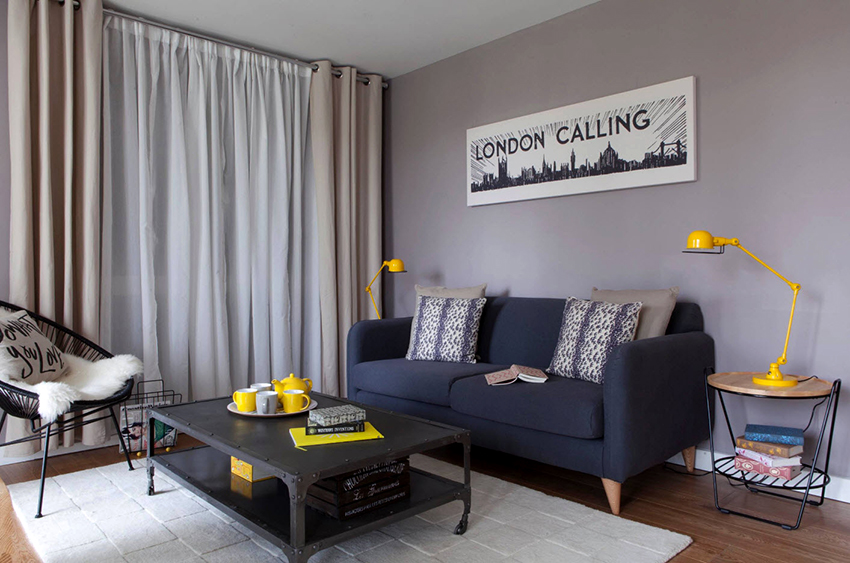
Curtains and tulle can be made both in one color scheme and in contrasting
Helpful advice! To make the tulle curtain look aesthetically pleasing and complement the interior, its open part must have a width of at least 120-150 cm (depending on the width of the curtains).
Simple and elegant: tulle for a small room
The hall is usually set up in the largest room in a house or apartment. However, in old-style buildings, even the most spacious room can be small. Heavy curtains in such a room are completely inappropriate. Even lightweight canvases can be redundant. Windows of small rooms can be decorated only with tulle, without using denser fabrics.
In the photo - tulle for the hall with various technical decorative treatments. The canvases are embroidered, have a pattern, an original edge. Interesting options are when tulle with fluffy gathers in the upper part is complemented by a rigid lambrequin. The fabric flows down, creating an atmosphere of lightness, airiness.
For windows with large fragments of glazing, it is appropriate to use material with a large expressive pattern. You can decorate a room in a Scandinavian style with beautiful tulle. For these purposes, you need to choose a smooth white fabric with a dense weave (that is, with small cells). Interesting models from this material are easy to make using hooks.
If the tulle curtain looks lonely on the window, you should use eyelets. They will complete the composition. On eyelets you should hang tulle with embroidery or additional weaving, that is, heavier fabric options. Airiness and eyelets do not match well.
Roman blinds in the hall: photos of natural and synthetic fabrics in the interior
Roman blinds are used to create an interesting interior. These are canvases designed to fit the window, opening by vertical lifting. They come in several varieties:
- The classic version. The web is collected in folds during the lifting process.
- Cascading curtains. They are folded fabric. When lifting, the warehouses form a cascade.
- Frameless models. When lifting, the soft cloth is collected from both sides.
These curtains can be used in almost any interior. To carry out such window decoration in the hall, the design of the curtains should be selected in accordance with the general color scheme of the room. For the manufacture of curtains, both natural and synthetic materials are used. Of natural fabrics, linen and cotton are often used. Canvases can be plain and colored. Warehouses made of this material are soft and pleasant. For many interiors, only natural textiles are acceptable.
Studying advertising photos of the curtain design in the hall, you should pay attention to the fact that many models are made of synthetic fibers. It should be noted that such Roman blinds, in comparison with natural ones, have a number of advantages:
- lungs;
- easy to care for;
- resistant to sunlight;
- retain aesthetics for a long time.
Helpful advice! It is not recommended to use colorful roman blinds for panoramic windows. A large number of shades can ruin the interior.
Designer tips: photo of curtains for the hall with bay windows
The purpose of bay windows, in addition to creating an architectural image, is to increase the natural lighting of the room.The protruding part is more than half (sometimes completely) composed of windows. The decoration of the bay windows should add decorativeness to the room and not limit the amount of incoming daylight.
Another mandatory requirement is strict adherence to style. If this rule is violated, part of the room turns into an additional low-functional area.
Curtains are almost always appropriate in the hall. Light sheer fabric on the windows enlivens the room. It is better to hang thick curtains on bay windows so that when open they are along the wall and do not block the skylight. If you are using roman blinds, you should choose models that, when raised, take up a small area of the window. Classic or frameless models will do.
If there are small walls between the windows, it is appropriate to arrange the area with light chiffon. The original design options for the curtains for the hall with the bay window can be seen in the photo on the Internet. These are combinations of canvases of various shades, lengths, and laconic shapes.
Helpful advice! The curtain rod for hanging curtains in the bay window should be fixed to the ceiling, regardless of the height of the room. A lower position creates an unnecessary visual boundary.
Modern types of cornices used for hall curtains
Considering the photo of the curtains in the hall, you should pay attention not only to their color, style, decorative features, but also to the cornice. It is not worth diminishing the meaning of this element of the overall composition. It is a correctly selected cornice that ensures the required position of the curtains, while maintaining their decorative effect and aesthetics.
Modern cornices are made from the following materials:
- wood;
- metal;
- plastic;
- composite compositions.
By the type of attachment and shape, the following product options are distinguished:
- profile;
- baguette;
- strings.
The designs are mainly double and single. Double are used for hanging curtains and curtains or identical canvases in two rows to achieve decorativeness. Can be used for curtains with lambrequins in the hall. Photos of such compositions are often found on the Internet. Canvases of one functional purpose are placed on single cornices.
An important detail of the profile cornices is the tips. These are open parts that must match both the curtain design and the interior of the room as a whole. The composition of velvet canvases is successfully accentuated by gilded tips. The curtain rod for lightweight tulle can be decorated with tapered or rounded metal mesh elements.
An interesting addition to the room is the cornice molding. It consists of a decorative strip and a main structure on which curtains are hung with hooks. This cornice can be attached to a ceiling or wall. The design of the plank is intended to complement the window composition and decorate the interior of the hall.
String cornices are rarely used in the interior. Thin and lightweight canvases are hung on them.
How to sew beautiful curtains for the hall with your own hands
For those who have minimal skills in using a sewing machine, even the most primitive one - manual, it will not be difficult to sew beautiful curtains into the hall with your own hands. The first thing to start with is to choose a model. If the idea is taken from the Internet, you should carefully read the proposed information about the chosen option, regarding the quality of the main fabric and decor materials.
The sequence of actions can be as follows:
- Perform the necessary measurements: the distance from the floor to the eaves, the width of the window opening, the length of the eaves.Take into account the size of the fasteners used for the curtains, add allowances for the seams (5-6 cm on each untreated side), for other decorative elements used.
- Calculate and purchase the required amount of fabric. Buy braid, harnesses and other additional materials used to create a composition.
- Purchase threads. They are selected 1-2 shades darker than the color of the fabric. For braid and other edging methods, you need to use threads to match the materials.
- Cut out curtains and all fabric decorative elements. Finish the edges.
- Carry out technical decoration in accordance with the selected model.
Important! When sewing curtains, overcasting is not used as a method of overcasting. The edges need to be wrapped and stitched.
Window decoration only at first glance may seem like an uncomplicated and exciting exercise. In fact, it requires knowledge, skills, a sense of proportion and a certain taste. Not everyone has design skills. The right decision would be to go to the Internet and view the photo. Tulle for a room of modest size, delicate muslin for non-standard windows, dense gabardine for a classic interior - professionals will help you make the right choice of a suitable model.


